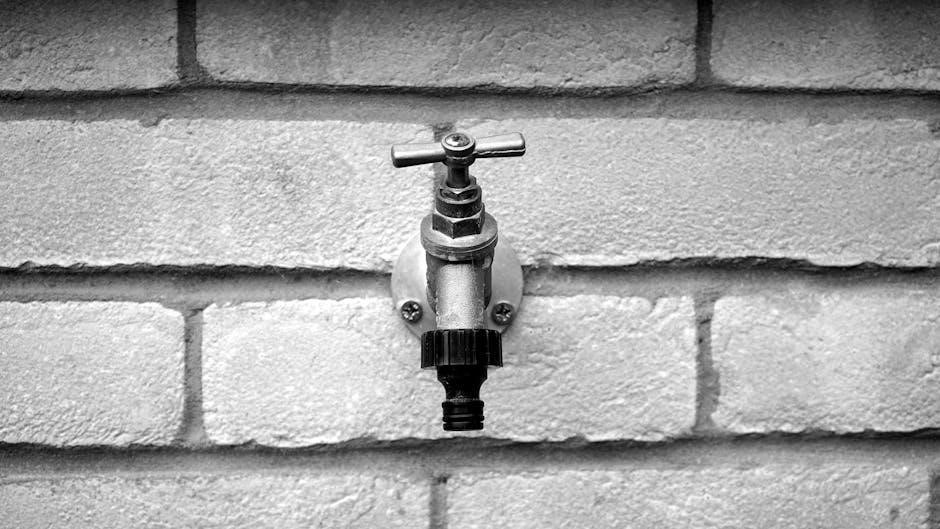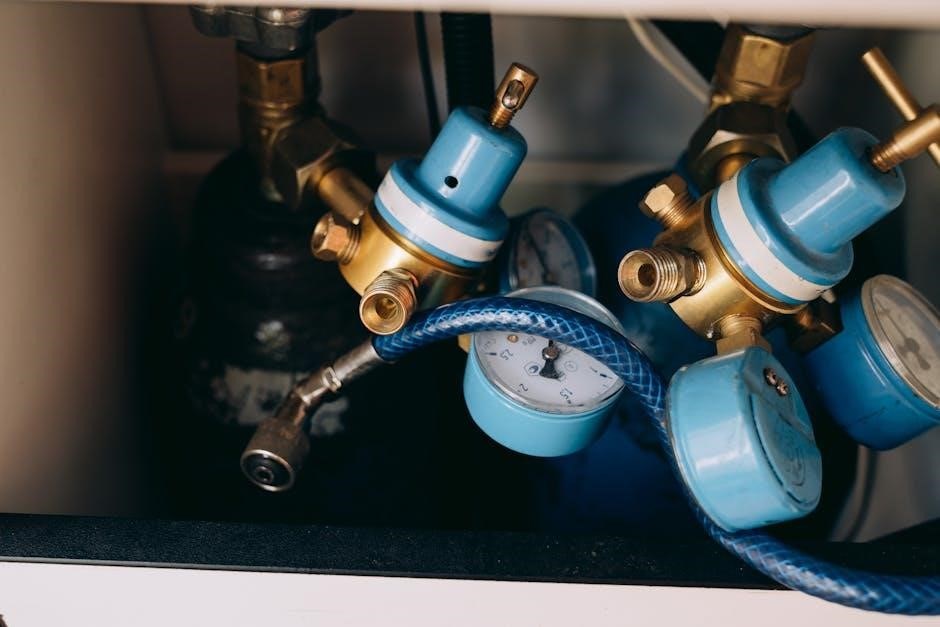Pipe benders are essential tools for shaping pipes and tubes into precise angles and forms. They are widely used in plumbing‚ automotive‚ and HVAC industries. This guide provides insights into types‚ materials‚ and techniques for effective pipe bending‚ ensuring durability and accuracy in various applications.

Types of Pipe Benders
Pipe benders come in manual‚ hydraulic‚ and CNC models‚ each offering unique advantages. Manual benders are simple and cost-effective‚ while hydraulic and CNC benders provide precision and efficiency for complex tasks.
Manual Pipe Benders
Manual pipe benders are cost-effective tools for bending pipes and tubes. They are commonly used for smaller diameters and less complex bends. These benders rely on physical effort‚ making them ideal for small-scale projects. They are portable and easy to use‚ offering simplicity and affordability. Manual benders are suitable for plumbers and DIY enthusiasts who need precise control over the bending process without requiring advanced machinery.

Hydraulic Pipe Benders
Hydraulic pipe benders use hydraulic power for efficient and precise bending. They are ideal for thicker materials and complex bends‚ reducing labor intensity. These benders offer higher bending capacity and are commonly used in industrial settings. Hydraulic models provide consistent results and are preferred for heavy-duty applications‚ ensuring accuracy and durability in various industries like construction and automotive.
CNC Pipe Benders
CNC pipe benders are advanced machines offering high precision and automation. They use computer-controlled systems to bend pipes with intricate angles and complex shapes. Ideal for high-volume production‚ CNC benders ensure consistency and accuracy. They are widely used in industries requiring tight tolerances‚ such as automotive and aerospace. These machines minimize human error and maximize efficiency‚ making them a preferred choice for modern manufacturing needs.

Materials That Can Be Bent
Pipe benders work with various materials‚ including metal‚ plastic‚ and exotic alloys. Each material requires specific techniques and tools to achieve precise bends without damage.
Metal Pipes
Metal pipes are commonly bent using pipe benders due to their durability and versatility. These pipes are widely used in plumbing‚ automotive‚ and HVAC systems. Manual‚ hydraulic‚ and CNC benders are employed depending on the desired precision and application. Thicker metals may require hydraulic or CNC machines for accurate bends‚ while thinner metals can be shaped with manual tools; Proper bending techniques ensure the pipe’s structural integrity is maintained‚ avoiding cracks or damage.
Plastic Pipes
Plastic pipes are bent using specialized techniques and tools to avoid cracking or deforming. They are commonly used in plumbing and HVAC systems for their flexibility and resistance to corrosion. Manual and hydraulic benders are often employed‚ with careful consideration of the pipe’s thickness and material type. The bending process must be precise to maintain the pipe’s integrity and ensure leak-free connections. Proper tools and methods are essential for achieving accurate and durable bends in plastic pipes.
Exotic Materials
Exotic materials like titanium‚ Inconel‚ and advanced composites require specialized bending techniques. These materials are used in high-performance applications‚ such as aerospace and chemical processing. CNC pipe benders are often employed due to their precision and control. The bending process must account for the material’s unique properties‚ such as high strength and resistance to corrosion. Proper tooling and expertise are crucial to achieve accurate bends without compromising the material’s integrity or performance capabilities.
Selection Criteria for Pipe Benders
Selecting the right pipe bender involves considering pipe diameter‚ thickness‚ and material type. Evaluate bending capacity‚ precision needs‚ and compatibility with existing tools for optimal performance.
Pipe Diameter and Thickness
Pipe diameter and thickness are critical factors in selecting a pipe bender. The tool must accommodate the pipe’s size without causing damage. Thicker pipes require more robust benders‚ while thinner ones need precision to avoid kinking. Ensuring compatibility between the bender and pipe dimensions is essential for achieving accurate bends and maintaining structural integrity. Proper alignment and tooling prevent deformation‚ making diameter and thickness key considerations for successful bending operations.
Bending Capacity

Bending capacity refers to the maximum angle or radius a pipe bender can achieve without damaging the material. It varies by machine type‚ with hydraulic and CNC benders offering higher precision for complex bends. Manual benders are suitable for smaller‚ less intricate projects. Selecting the right capacity ensures the pipe’s structural integrity is maintained. Exceeding the bender’s capacity can lead to deformation or breakage‚ emphasizing the importance of matching the tool to the job requirements for safe and effective bending operations.
Precision Requirements
Precision requirements determine the accuracy needed for bending pipes‚ varying by application. CNC benders excel in high-precision tasks‚ such as aerospace‚ while manual benders suffice for less demanding jobs. Hydraulic benders offer moderate precision‚ suitable for automotive and HVAC systems. Ensuring the bender meets precision standards prevents material waste and ensures structural integrity. Proper tool selection based on required accuracy is crucial for achieving desired results and maintaining project quality across industries. This ensures reliable and consistent outcomes in pipe bending operations.
Compatibility with Bending Tools
Compatibility with bending tools ensures seamless operation and optimal results. Different pipe benders require specific dies‚ mandrels‚ and wiper dies to match the pipe’s diameter and material. Manual benders often use interchangeable dies‚ while hydraulic and CNC benders rely on precise tooling setups. Ensuring compatibility prevents damage to both the pipe and the bending equipment. Proper tool alignment and fit are critical for achieving accurate bends and maintaining the integrity of the material being shaped. This ensures efficient and reliable bending processes across various applications.
Pipe Bending Techniques
Pipe bending techniques vary‚ including manual‚ hydraulic‚ and CNC methods. Each technique offers unique advantages‚ ensuring precise angles and shapes for diverse applications in plumbing‚ automotive‚ and construction industries;
Manual Bending
Manual bending is a straightforward technique using handheld tools to shape pipes. It’s ideal for small-scale projects‚ offering simplicity and cost-effectiveness. This method is best for smaller diameters and precise‚ localized bends. Manual benders are portable and require minimal setup‚ making them perfect for on-site adjustments. They rely on physical effort‚ making them suitable for low-volume tasks. While less efficient for large-scale applications‚ manual bending excels in tight spaces and for creating custom angles with minimal equipment.
Hydraulic Bending
Hydraulic bending uses hydraulic power to shape pipes and tubes‚ offering greater efficiency and reduced manual effort. This method is ideal for bending thicker materials and heavier gauges. Hydraulic benders provide precise control and consistent results‚ making them suitable for industrial and large-scale applications. They are commonly used in automotive and construction industries for creating complex bends. Hydraulic systems ensure faster operation and higher accuracy compared to manual methods‚ making them a preferred choice for professionals requiring reliability and performance.
CNC Bending
CNC bending is a highly precise method that uses computer-controlled machines to bend pipes and tubes with utmost accuracy. It is ideal for complex shapes and tight tolerances‚ often used in automotive and HVAC industries. CNC benders utilize pre-programmed settings to achieve consistent results‚ reducing human error. This technique is particularly effective for repetitive tasks and large-scale production‚ ensuring efficiency and reliability. It is widely adopted for bending exotic materials and intricate profiles‚ making it a cornerstone of modern manufacturing processes.
Applications of Pipe Benders
Pipe benders are crucial in plumbing‚ automotive‚ HVAC‚ and construction industries. They enable precise shaping of pipes for installations‚ repairs‚ and custom fabrications‚ ensuring durability and functionality across various sectors.
Plumbing
In plumbing‚ pipe benders are indispensable for creating custom pipe configurations. They allow for precise bends in water supply lines‚ drainage systems‚ and gas pipes‚ ensuring proper connections and minimizing leaks. Plumbers rely on manual and hydraulic benders to navigate tight spaces and meet specific fitting requirements. This versatility ensures efficient installations and repairs‚ maintaining system integrity and performance. Pipe benders are essential for modern plumbing‚ enabling professionals to handle complex layouts with ease and accuracy.
Automotive
In the automotive industry‚ pipe benders are crucial for fabricating custom exhaust systems‚ fuel lines‚ and brake lines. They enable precise bends for optimal performance and durability. Automotive technicians use manual and hydraulic benders to create complex configurations‚ ensuring proper fitment and functionality. Pipe benders are essential for both classic car restorations and modern vehicle modifications‚ allowing for tailored solutions that meet specific engineering requirements. Their versatility ensures reliable and efficient automotive systems‚ making them indispensable in the industry.
HVAC
Pipe benders play a vital role in HVAC systems for creating ductwork and piping. They enable precise bends for efficient airflow and system performance. Roll bending is commonly used for large-radius bends‚ ideal for spiraled pipes in HVAC applications. Pipe benders ensure durability and proper fitting‚ essential for maintaining system integrity. Whether for metal or plastic pipes‚ precise bending techniques are crucial for optimal HVAC functionality‚ making pipe benders indispensable in this field.
Construction
Pipe benders are crucial in construction for creating structural frameworks‚ handrails‚ and support systems. They enable precise bending of metal and plastic pipes‚ ensuring durability and proper fitting. Roll bending is often used for large-radius bends‚ ideal for construction projects requiring complex pipe configurations. Pipe benders contribute to the efficiency and safety of construction by providing accurately shaped pipes‚ which are essential for building stability and functionality. Their versatility makes them indispensable in modern construction projects.

Tools and Accessories
Essential tools include die sets‚ bending springs‚ and rollers. Accessories like lubricants‚ gloves‚ and storage cases enhance efficiency and protect equipment‚ ensuring optimal pipe bending performance.
Essential Tools
Essential tools for pipe bending include die sets‚ bending springs‚ and rollers. Die sets shape the pipe‚ while springs prevent kinking. Rollers assist in hydraulic bending. Lubricants reduce friction‚ protecting pipes during bending. These tools ensure precise‚ efficient bending across various materials and applications‚ maintaining pipe integrity and achieving desired angles. Proper tool selection is critical for successful pipe bending projects‚ whether manual‚ hydraulic‚ or CNC-based. They are indispensable for professionals in plumbing‚ automotive‚ and HVAC industries.
Accessories
Key accessories for pipe benders include bending dies‚ springs‚ and lubricants. Bending dies shape the pipe‚ while springs prevent kinking. Lubricants reduce friction‚ protecting pipes during bending. Additional accessories like measuring tools and safety gear enhance precision and safety. These components are vital for maintaining equipment performance and ensuring accurate bends. Accessories vary by bender type‚ with hydraulic systems requiring specific dies and CNC benders needing digital interfaces. They play a crucial role in optimizing bending processes across industries‚ ensuring durability and efficiency in pipe shaping tasks.
Maintenance and Care
Regular maintenance ensures pipe benders function optimally. Clean equipment after use‚ lubricate moving parts‚ and store in dry areas. Inspect for wear and tear‚ replacing worn components promptly to maintain performance and longevity.
Regular Maintenance
Regular maintenance is crucial for extending the life of pipe benders. Clean the equipment thoroughly after each use to remove dirt and debris. Lubricate all moving parts to ensure smooth operation and prevent rust. Check for worn or damaged components and replace them promptly. Store the bender in a dry‚ cool place to avoid corrosion. Schedule periodic inspections to maintain accuracy and performance‚ ensuring reliable results in every bending task.
Storage Tips
Proper storage of pipe benders is essential to maintain their functionality. Store the equipment in a dry‚ cool environment to prevent rust and corrosion. Use protective covers or cases to shield against dust and moisture. Avoid stacking heavy objects on top of the bender to prevent damage. Keep the tool in an upright position to maintain balance and stability. Regularly inspect stored benders for signs of wear or damage before reuse‚ ensuring they remain in optimal condition for future projects.

Safety Considerations

Always wear protective gear‚ including gloves and safety glasses‚ when operating pipe benders. Ensure proper training and follow manufacturer guidelines to avoid accidents and injuries.

Safety Precautions
When using pipe benders‚ always wear protective gear like gloves and safety glasses to prevent injuries. Ensure the machine is properly secured and follow the manufacturer’s guidelines. Regularly inspect the equipment for wear and tear‚ and perform maintenance as recommended. Keep loose clothing tied back and avoid overreaching. Proper training is essential to operate pipe benders safely. Never leave the machine unattended while in operation‚ and ensure the workspace is clear of obstacles. Adhering to these precautions minimizes risks and ensures a safe working environment.
Best Practices
Always follow manufacturer guidelines and ensure proper training before operating pipe benders. Use appropriate tools and accessories for the job to maintain precision and safety. Regularly inspect and maintain equipment to prevent malfunctions. Align the pipe correctly before bending to achieve accurate results. Avoid overloading the machine beyond its capacity. Keep the workspace clean and well-organized to enhance efficiency. After bending‚ inspect the pipe for any damage or deformities. Properly store tools and equipment to extend their lifespan and ensure optimal performance in future tasks.

Future Trends
Future trends in pipe bending include advancements in automation‚ AI-driven machines‚ and eco-friendly materials. Industry developments focus on precision‚ efficiency‚ and sustainability‚ shaping the next generation of pipe benders.
Technological Advancements
Technological advancements are revolutionizing pipe bending‚ with CNC machines offering precision and automation. AI optimizes bending parameters‚ reducing errors. Smart technologies enable real-time monitoring and adjustments‚ enhancing efficiency. These innovations not only improve productivity but also support eco-friendly practices by minimizing waste and energy consumption‚ aligning with modern industry demands for sustainable solutions.
Industry Developments
The pipe bending industry is evolving rapidly‚ with a focus on automation and sustainability. CNC pipe benders are becoming standard‚ offering unmatched precision and efficiency. Manufacturers are investing in eco-friendly materials and energy-efficient machines to meet global sustainability goals. Additionally‚ the rise of smart factories and Industry 4.0 technologies is transforming production processes‚ enabling faster and more accurate pipe bending solutions. These developments are driving innovation and setting new standards for the future of pipe bending.
Pipe benders are indispensable tools for shaping pipes and tubes across various industries. From manual to CNC models‚ they offer precision and efficiency. Selecting the right bender ensures durability and accuracy. As technology advances‚ automation and sustainability are reshaping the industry. By understanding types‚ materials‚ and techniques‚ professionals can achieve flawless results. This guide provides a comprehensive overview‚ helping users make informed decisions and stay ahead in their respective fields. Pipe benders continue to evolve‚ meeting the demands of modern applications.
